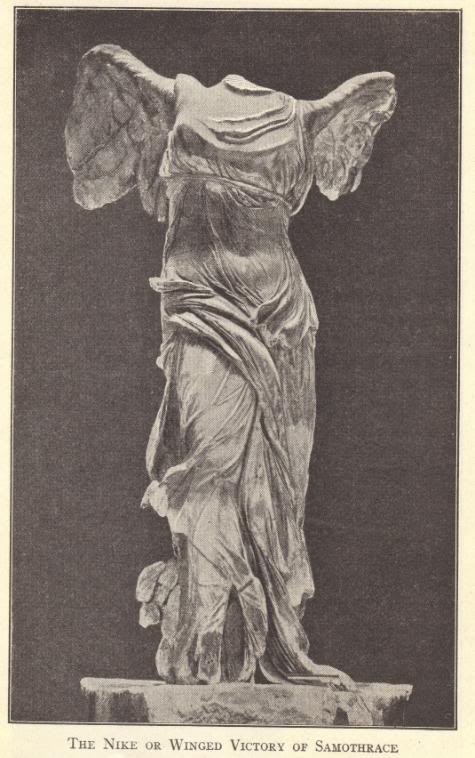| Winged Victory of Samothrace |
|---|
| www.studenthandouts.com ↣ World History ↣ Ancient Greece ↣ Images of Ancient Greece |
|
The Winged Victory of Samothrace, also known as the Nike of Samothrace, is culturally significant for several reasons.
Click here to enlarge.
Artistic Mastery: The Winged Victory of Samothrace is celebrated as a masterpiece of Hellenistic sculpture. It is renowned for its exceptional artistry, dynamic composition, and attention to detail. The statue's flowing drapery, intricate feathered wings, and lifelike rendering of the human form demonstrate the skill and innovation of the ancient Greek sculptor.  Historical Significance: The statue dates to the 2nd century B.C.E. and is believed to commemorate a naval victory. It was discovered on the island of Samothrace, which was a significant religious and cultural center in the ancient world. The statue's dedication to the goddess Nike (Victory) suggests its role in celebrating military successes.
Historical Significance: The statue dates to the 2nd century B.C.E. and is believed to commemorate a naval victory. It was discovered on the island of Samothrace, which was a significant religious and cultural center in the ancient world. The statue's dedication to the goddess Nike (Victory) suggests its role in celebrating military successes.
Symbol of Victory: The Winged Victory of Samothrace is an iconic representation of victory and triumph. The statue's dynamic pose, with outstretched wings, conveys the sense of a triumphant figure descending from the heavens. It captures the spirit of victory, which was highly valued in ancient Greek culture. Aesthetic Influence: The statue's striking form and design have had a lasting impact on the world of art and sculpture. It has influenced countless artists and sculptors throughout history, including those of the Renaissance and neoclassical periods. The Nike of Samothrace has contributed to the development of artistic conventions for representing victory and dynamism in sculpture. Museum Exhibit: The Winged Victory of Samothrace is currently displayed at the Louvre Museum in Paris, one of the world's most prestigious art museums. Its prominent placement in a renowned museum has made it accessible to a global audience, further enhancing its cultural significance. Cultural Heritage: The statue is a testament to the artistic and cultural achievements of ancient Greece, which continue to captivate and inspire people today. It serves as a symbol of the enduring legacy of Greek art and culture. Archaeological Discovery: The circumstances of the statue's discovery on the island of Samothrace in 1863 add to its allure. It was found in the ruins of the Sanctuary of the Great Gods, an archaeological site associated with religious and mystical rituals. The Winged Victory of Samothrace stands as a symbol of ancient Greek culture, artistic achievement, and the enduring fascination with victory and triumph. Its combination of artistic excellence and historical significance continues to make it a revered and admired work of art. |
 |  |  |  |  |  |
| Ancient Greece Books and Films | Ancient Greece Outlines and PowerPoints |
| Ancient Greece Maps and Pictures | Ancient Greece Study Games |
| Ancient Greece Miscellany | Ancient Greece Worksheets |
| www.studenthandouts.com ↣ World History ↣ Ancient Greece ↣ Images of Ancient Greece |








